The entire health/nutrition/wellness/fitness industry got its ass handed to it by Google earlier this week with a broad search algorithm update.
The update primarily punished sites in the YMYL niche that had low EAT.
YMYL – Your Money Your Life; any website that gives you advice on someone’s finances, health, or happiness.
EAT:
- E – expertise
- A – authoritativeness
- T – trustworthiness
(Don’t hate me for these acronyms – it’s something Google came up with).
EAT answers the question of “is this person worthwhile listening to? Is it a real expert or someone anonymous spouting off an opinion like a fact.”
This has been my approach to SEO from day one, and I am more than ever sure that this is a harbinger of what is coming.
Examine.com is smack dab in the middle of YMYL, and our traffic went up after this update.
As information continues to be manipulated for financial gain, Google is trying to figure out what signals it can best trust when sending a user to someone’s website.
Google is trying to figure out how to best ascertain who should be ranked at the top, and EAT is their best solution.
Creating EAT
Consider this a quick guide on how to reverse engineer EAT. If you want to get deeper, four worthwhile articles to read:
- Google’s original Quality Raters’ Guidelines (QRG)
- Google’s new creator reputation
- The August 1 2018 Google Update
- EAT and YMYL
A lot of people don’t know that Google has contracted over 10,000 people worldwide that look at their search results, rate the quality of the results (and websites), and move on.
This human element is critical in establishing EAT.
I want you to think as Google and try to reverse-engineer how they would figure out if you can be trusted
Google’s Page Quality Rating (PQR)
Google has a document that outlines what it wants their raters to look for.
In 3.1, they state the most important factors are for page quality rating (PQR) are:
- The purpose of the page
- EAT
- Main Content (MC) quality and amount
- Website info/info about who is responsible for MC
- Website reputation/reputation about who is responsible for MC
Ignoring the first and third points, the rest are all a reflection of reputation and trust.
So I give you three simple steps to help you bolster yourPQR.
(Caveat emptor: these steps are a mixture of my experience, what I’ve read, and analyzing sites that went up and sites that went down).
I give you three simple steps to take right now to increase your page quality rating.
1. Establish your trust
The first thing Google wants to know is if the website can be trusted.
To quote:
“Satisfying website information and/or information about who is responsible for the website. If the page is primarily for shopping or includes financial transactions, then it should have satisfying customer service information.”
You need to have an about page – you need to elaborate on who you are and why they should listen to you.
You need to have a contact page. You need to have customer support information.
Furthermore, if you are publishing content, you should have editorial guidelines. Google specifically cites BBC and USA Today for their editorial policies.
Google wants to know you are a real organization and that you’ve put in energy and effort into the content you are producing.
To quote them:
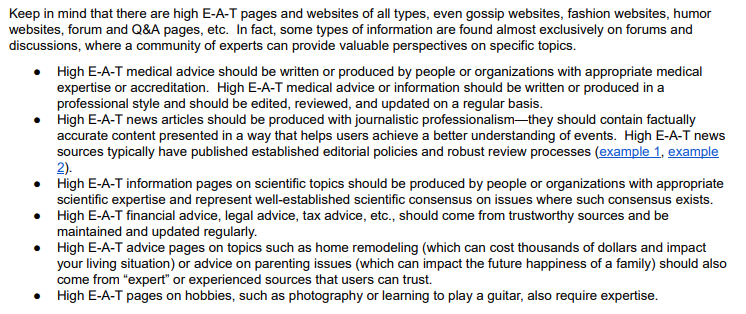
Establish and prove that you’re a real organization. Having information about your company (about), let them contact you (contact), and show that you’ve done work in your content creation process (eg editorial policy)
2. Show your authorship
Google wants to know who is writing an article. They care about who is writing an article.
So make sure you give proper attribution to who the writer is.
Use their full name. Show a picture. If you have space for a byline, explain why this person is of note.
Currently on Examine.com we show authorship like so:
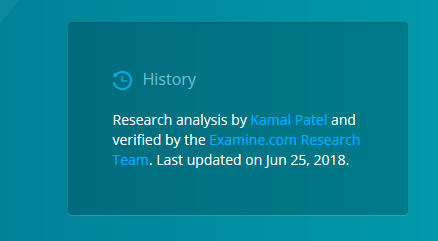
The new design we’ve been working on adds the image:
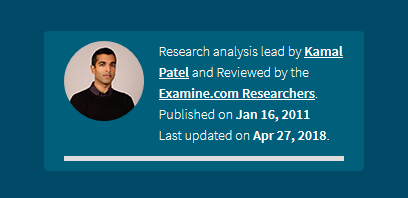
In order to make sure Google explicitly understands its the author, you should also add the appropriate schema for it.
To make it easier, you can use Google’s Data Highlighter. You can see what it looks like here:

Furthermore, link to their social media profiles. The raters have been specifically told to look for social media links for content creators.
Plus, Google considers them as part of their Knowledge panel.
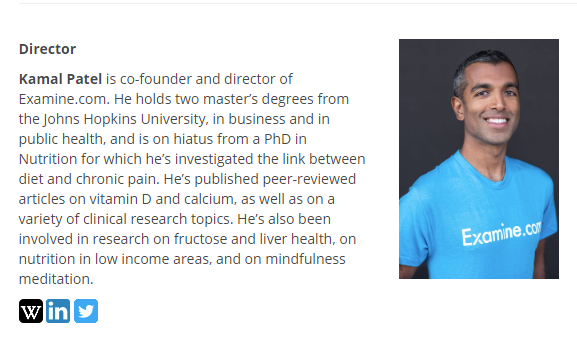
You’ll see we even linked to his wikipedia page to show how smart Kamal is.
Establish an obvious link between the content that is being consumed and who created it.
3. Establish authority of said author
So Google knows you’re a real organization. They know who wrote the content. Now they need to know why the hell they should trust you.
Basically, you need to brag.
Explain where your expertise comes from.
It should be noted that Google understands that expertise is not necessarily formal education:

Talk about the accomplishments of the author. Talk about any accolades they have received, along with any awards or certificates. Have they written a book? Have they spoken at conferences? Have they been profiled in the mainstream? Did they go to a famous institution or work with someone else famous?
You are trying to establish “this person knows their shit, and this is why you should listen to them.”
This is your time to rub in that social proof.
And as I previously stated, link to social media accounts.
If there is an important website/association that your author is a part of, link to it!
For example, in research, you would have a ResearchGate profile. In design, you’d have a dribbble profile. As a journalist in health, you may be part of the Association of Health Care Journalists (AHCJ).
You don’t have to have an individual page for each author. We don’t. Healthline doesn’t (and they crush on Google). It depends on the site structure. You just want to elaborate on who the author is.
You need to establish why the author is worthwhile listening to.
Go through someone else’s shoes
Best way to fully understand this is through a real example – SJO.com.
Pretend you have no idea who I am. How do I establish EAT?
- On the SJO.com home page, I let you know I have experience (15+ years of experience, multiple companies, significant revenue generated).
- My article titles are non-sensationalist or clickbait-y.
- At the bottom of each page I link to my Facebook and Twitter accounts.
- If you were to visit either Facebook or Twitter, you’d see that I have a decent-sized following and am verified on both networks. Furthermore, you’ll see high engagement on both.
- My contact and about page are linked from every page on the website. There is also a pic of me so you can see I’m real.
- On my about page I go into length as to why I created SJO.com, my backstory, on how I have no desire to monetize SJO, and the multitude of mainstream publications I’ve been in. I talk about my charity endeavors, link to my Wikipedia article, and name-drop being a digital advisor to Arnold Schwarzenegger.
There is no single factor that will make you say “okay this person is legitimate.” But I took all the steps outlined above, and collectively, I’m pretty confident you would walk away saying “yup, this person is legit.”
EAT is just a systematic way of saying “yup, this person is legit.” Ensure you send out signals that vouch for you.
Only hacks use hacks
At the end of the day, Google considers some 200+ signals when ranking your website. Your site speed. Your site’s structure. Your links profile. And so forth and so forth.
I’m not a believer in trying to manipulate Google. One of the tools that had become en vogue before this update was having sensationalist headlines that did not match up with the content. Google smacked those sites way down.
It’s a game of cat-and-mouse, with Google the cat. I’ll pass on being the mouse.
Purely from a user-perspective, it’s a no-brainer to implement EAT into your website. It’s a small investment that could have huge benefits.
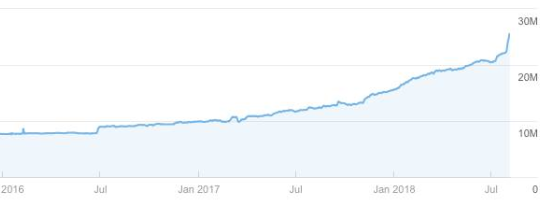
Leave a Reply